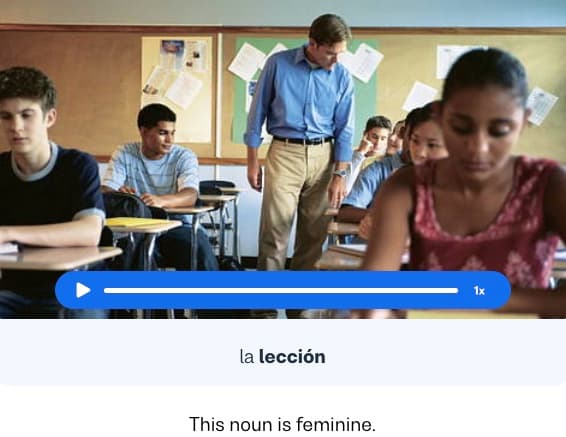I want to learn...
How does noun gender work in Spanish?
How can you work out the difference between feminine and masculine nouns?
Noun genders are always tricky to master when you’re learning a new language, but this guide will help you spot the difference between feminine and masculine nouns, and learn how to use each properly. So, let's get started!
How is gender used with nouns in Spanish?
Wondering how to decide if a noun is feminine or masculine? Which article do you use for a feminine noun or adjective ending? No worries! ¡Esta lección no es imposible! This lesson is not impossible!
Let’s review what you already know about nouns. Nouns are words that name people, animals, plants, objects, feelings and ideas. The first thing to take into account is that nouns in Spanish have a gender: feminine or masculine, but they can also be singular or plural.
So every word for a person, place, thing or idea is either masculine or feminine. This can be confusing, but it’s necessary and worthy of learning to avoid embarrassing slip-ups when speaking in Spanish.
How to spot Spanish feminine and masculine nouns
Feminine and masculine nouns in Spanish have specific endings. This will make things easier for you to identify if a noun is feminine or masculine. All nouns are split into these two genders in Spanish.
Feminine noun endings
Spanish noun endings -a, -ción, -ía, or -dad, -ed, -id, -od, -eza and -is are usually feminine.
Here are some examples of each noun ending:
Nouns ending in -a
La tristeza (sadness)
La casa ( the house)
La vecina (the neighbour)
Nouns ending in -ción which is equivalent to -tion in English.
La canción (the song)
La purificación (the purifying)
La legislación (the legislation)
Nouns ending in -ía, -ie-
Geografía (geography)
Caligrafía (calligraphy)
La intemperie (the outdoor)
Nouns ending in-ad, -ed, -id, -ud
La ciudad (the city)
La verdad (the truth)
La sed (the thirst)
La pared (the wall)
La salud (health)
Nouns ending in-ez, -eza, -iz
La niñez (the childhood)
Solidez (solidity)
La nariz (the nose)
Nouns ending in-is
La crisis (crisis)
Tendinitis (tendinitis)
Apendicitis (appendicitis)
Exceptions when using Spanish feminine nouns
Watch out! ¡Cuidado! There are some exceptions…
While most l Spanish nouns that end in -o are masculine, some feminine nouns also end in -o:
La foto (the picture)
La mano (the hand)
There are also some masculine nouns which use feminine noun endings:
Masculine nouns that end in -d.
El ataúd (the coffin)
El césped (the grass)
El huésped (the guest)
Masculine nouns that end in -is
El arcoíris (the rainbow)
Bisturís (scalpels)
Grafitis (graffiti)
Masculine noun endings
Now let’s take a look at the common masculine noun endings in Spanish:-o, -an, -en, -in, -on, -un, an accented vowel,-or, -ate, -ete, -ote, or -aje.
Nouns endings in -o:
El niño (the boy)
El carro (the car)
El camino (the road)
Nouns endings in -an,-en, -in, -on, -un (tónicas):
Pan (bread)
Tren (train)
Camión (truck)
Común (common)
Nouns ending in an accented vowel are usually masculine:
-á - el sofá (the sofa)
-é - té (tea)
-és - estrés (stress)
Nouns ending in -ate, -ete, -ote:
Tomate (tomato)
Capote (cloak)
Elote (corn)
Banquete (feast)
Nouns ending in -aje:
El coraje (courage)
Abordaje (approach)
Equipaje (luggage)
Some other masculine nouns
There are also some other kinds of nouns which are also masculine.
In Spanish, days of the week are masculine:
El jueves (Thursday)
El lunes (Monday)
El viernes (Friday)
Compound and two-word nouns are also masculine:
El rascacielos (skyscraper)
Abrelatas (can-opener)
Tapabocas (face mask)
El sitio web (website)
El año luz (light-year)
Geographical names are masculine:
El Amazonas (the Amazon)
El Pacífico (the Pacific Ocean)
Some exceptions when using masculine nouns
Masculine nouns that end in-a:
El aroma (scent)
El clima (climate)
El cura (priest)
El diagrama (diagram)
Short words that end in -a:
Disco, discoteca (disco)
Foto, fotografía (picture)
Moto, motocicleta (motorbike)
How to use articles and adjectives with masculine and feminine nouns in Spanish
It's important to spot if a noun is feminine or masculine, as its gender will determine which article -el, la, los and las or adjective ending -a or -o to use with the noun.
Articles and adjectives with masculine and femenine nouns
| Noun | Singular article | Plural article | Adjective ending |
|---|---|---|---|
| Feminine | La | Las | -a, -as |
| Masculine | El | Los | -o, -os |
Use el (the) with singular masculine nouns and los (the) with plural masculine nouns. For masculine nouns use adjectives that end in -o.
El carro (the car)
Los carros (the cars)
El perro (the dog)
Los perros (the dogs)
Feminine singular nouns use the article la (The). Feminine plural nouns use las (The) and unas and adjectives that end in -a.
La niña (the girl)
Las niñas (the girls)
La casa (the house)
Las casas (the houses)
To change a masculine noun to a feminine, remove the -o and add -a.
Niño (boy)
Niña (girl)
Mesero (waiter)
Mesera (waitress)
For most nouns, to change singular nouns to plural, add -s.
Carro (car) - carros (cars)
Botella (bottle) - botellas (bottles)
Cama (bed) - camas (beds)
To form the plural of nouns that end in a consonant, add -es.
Mes (month) - meses (months)
Pared (wall) - paredes (walls)
Papel (paper)- papeles (papers)
Ley (law) - leyes (laws)
For Spanish nouns that end in -z, change the -z to a -c and then add -es to make them plural.
Pez (fish) - peces (fish)
Voz (voice) - voces (voices)
Gender agreement with adjectives
In Spanish, adjectives must match the noun gender and number, so if the noun is feminine, the article and adjective must be feminine as well. If the noun is plural, the adjective and article will also be plural.
Here are a few examples:
La pelota es blanca. (The ball is white.)
La mesa redonda (the round table)
El niño pequeño (the small boy)
Los perros negros (the black dogs)
Las niñas altas (the tall girls)
Newlanguages


